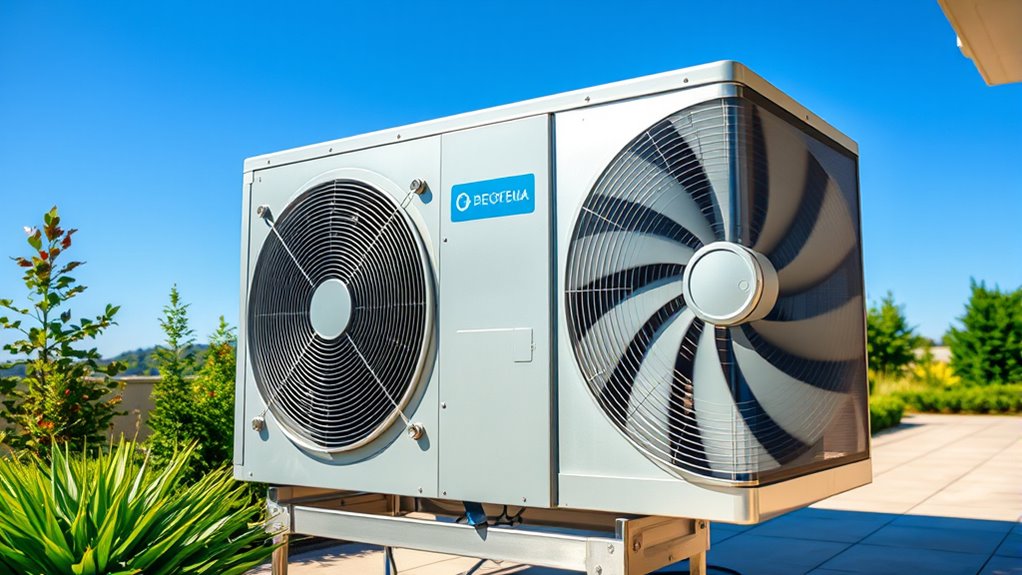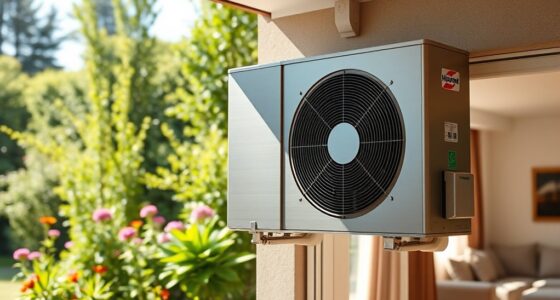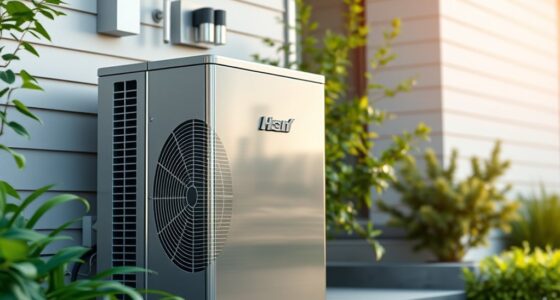Understanding the cooling capacity of heat pumps mainly involves knowing their BTU rating, which shows how much heat they can transfer per hour. Choosing the right BTU guarantees your system can efficiently handle your home’s size without short cycling or wasting energy. Too big or small a unit causes discomfort and higher costs. To achieve the best performance, it’s crucial to match your space and use professional sizing methods—keep exploring to learn more.
Key Takeaways
- BTU measures the heat transfer capacity of a heat pump, indicating how much heat it can remove or add per hour.
- Proper sizing of BTU ratings ensures efficient cooling, prevents short cycling, and maintains consistent home comfort.
- Larger BTU units (e.g., 24,000 BTU) are suitable for larger spaces, typically around 1,000 sq ft, depending on insulation and climate.
- Incorrect BTU sizing, either oversized or undersized, can lead to higher energy costs, reduced efficiency, and system wear.
- Professional load calculations, like Manual J, help determine the appropriate BTU capacity for optimal cooling performance.
What Does BTU Mean in Heat Pumps?
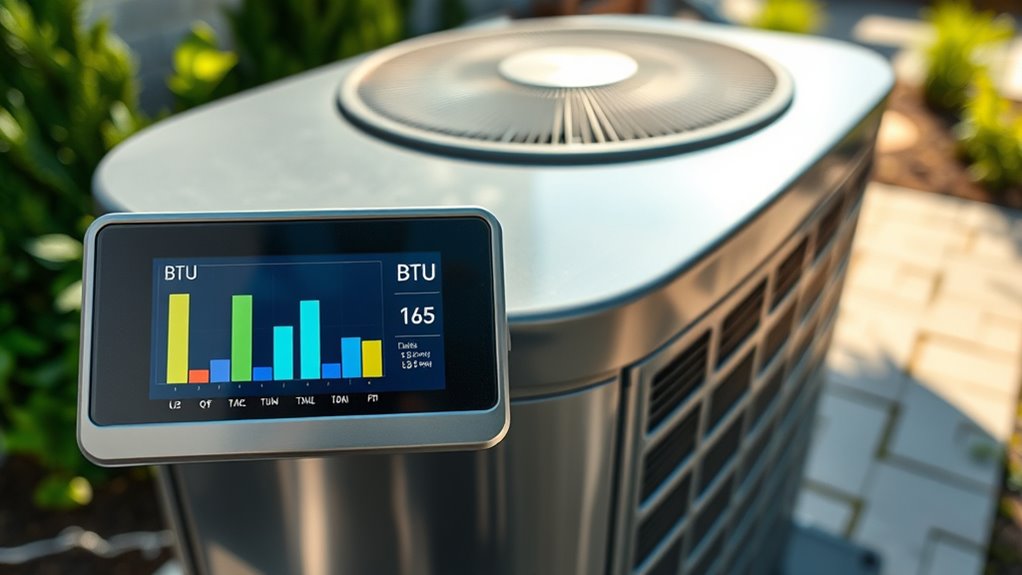
Understanding what BTU means in heat pumps is essential because it helps you gauge their cooling and heating capabilities. BTU, or British Thermal Unit, measures heat transfer — the amount of heat needed to raise or lower one pound of water by one degree Fahrenheit. When shopping for a heat pump, you’ll see its capacity expressed in BTUs per hour. This rating indicates how much heat the unit can transfer in that time, directly affecting its ability to cool or heat your space. Larger BTU ratings mean more powerful units, capable of handling bigger areas. For example, a 24,000 BTU heat pump, often called a 2-ton unit, offers significant capacity for moderate to large spaces. The BTU rating is a key factor in choosing a system suited to your cooling and heating needs. Proper sizing and installation are crucial for optimal performance and efficiency, and understanding the cooling capacity can also help in assessing the performance and longevity of your heat pump system over time.
Why Is the BTU Rating Crucial When Selecting a Heat Pump?
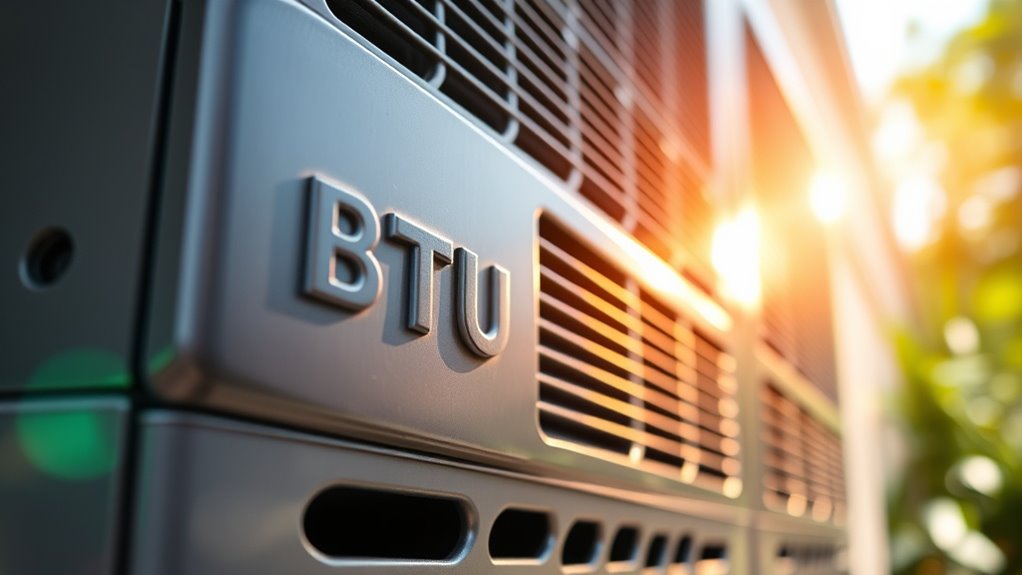
Choosing the right BTU rating for your heat pump is crucial because it directly impacts its ability to efficiently cool or heat your space. The BTU determines the cooling capacity, matching your home’s size and load calculations. A correctly sized heat pump ensures consistent comfort and prevents issues like short cycling, which reduces efficiency and shortens the system’s lifespan. If the BTU is too high, your heat pump will turn on and off frequently, wasting energy and increasing wear. Conversely, if it’s too low, the system will struggle to reach the desired temperature, leading to higher energy consumption as it works harder to maintain comfort. Proper sizing supports maximum efficiency and energy savings, making load calculations essential when selecting a heat pump to ensure it meets your home’s specific needs. Additionally, understanding the cooling capacity helps optimize the system’s performance and longevity, especially when considering Kia Tuning options that can enhance vehicle performance and handling. Accurate load calculations also reduce the risk of system inefficiency and help prevent premature equipment failure, ensuring reliable operation over time. A well-calculated BTU rating is also vital for system reliability, ensuring that your heat pump operates effectively over time without unnecessary strain. Furthermore, selecting the appropriate capacity can contribute to energy cost reduction, lowering your utility bills over the lifespan of the system.
Effects of Incorrect BTU Ratings on Home Comfort and Efficiency

Choosing the wrong BTU rating can cause your heat pump to cycle on and off too quickly, making your home feel uncomfortable and inconsistent. It can also lead to higher energy bills because the system isn’t running efficiently. Correctly sizing your unit helps make certain of steady comfort and lower operational costs.
Short Cycling Issues
Have you noticed your heat pump turning on and off frequently? That’s often due to short cycling caused by incorrect BTU ratings. When your unit is oversized for your space, it tends to short cycle, shutting off quickly after starting. This disrupts the heat pump’s capacity to maintain a consistent temperature and reduces efficiency. Short cycling also causes rapid wear and tear on components like the compressor, shortening your system’s lifespan. Properly sized units with accurate BTU ratings ensure your heat pump runs smoothly without unnecessary on/off cycles. Ensuring proper sizing is crucial for optimal performance and longevity. A correctly matched size improves comfort, maintains steady temperatures, and maximizes efficiency. Additionally, correctly rated units help prevent energy waste and reduce operational costs. Proper installation and system calibration are also vital to prevent short cycling issues. Avoiding short cycling means your heat pump operates at its ideal capacity, saving energy and reducing repair costs over time. Regular maintenance and accurate load calculations can further help prevent these problems and optimize system performance.
Increased Energy Costs
Did you know that incorrect BTU ratings can considerably hike your energy bills? An oversized heat pump with too high BTU capacity often causes short cycling, which wastes energy and raises your utility bills. Conversely, an undersized unit struggles to maintain consistent temperatures, forcing the system to run longer and increasing energy costs. Improper sizing leads to inefficient operation, reducing overall system performance and causing unnecessary wear and repair expenses. Overly large systems cool or heat spaces too quickly, resulting in temperature fluctuations and discomfort, which can trigger additional energy use. Properly matched BTU capacity ensures your heat pump operates efficiently, lowers energy costs, and improves home comfort. Additionally, consulting with HVAC experts can help ensure your system is properly sized for optimal performance and efficiency. Choosing the right cooling capacity is crucial for maximizing comfort and minimizing energy consumption over the lifespan of your system. It’s also important to understand energy efficiency standards and how they influence system selection, ultimately helping you achieve better energy savings. Being aware of system performance metrics can further aid in selecting an appropriately sized unit that aligns with your household needs. Understanding state tax implications for IRA withdrawals can also influence your financial planning, ensuring you optimize your savings and retirement income.
How to Determine the Appropriate BTU Capacity for Your Space
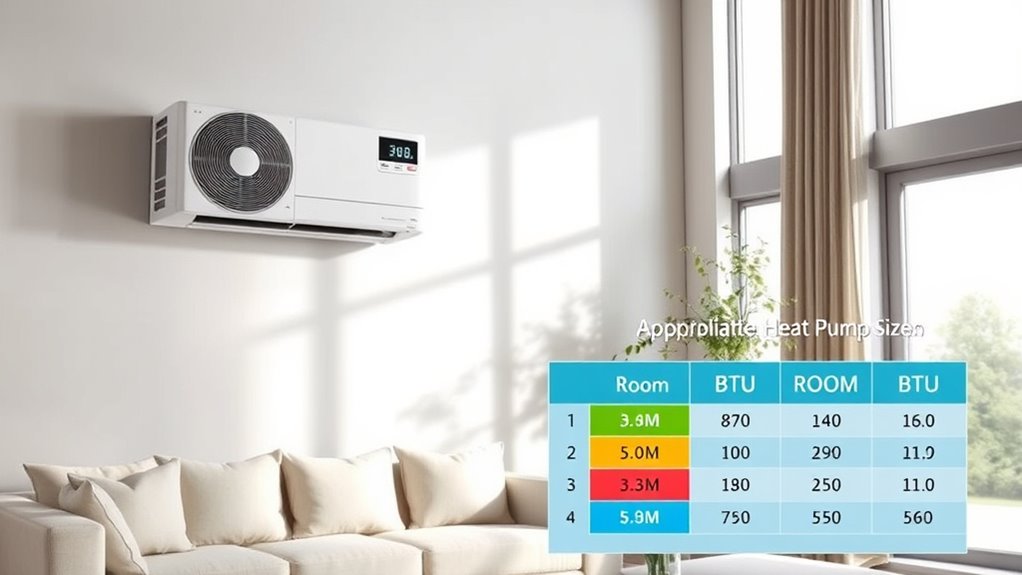
Determining the right BTU capacity for your space is essential to guarantee effective cooling without wasting energy. A general rule is that 12,000 BTUs (1 ton) suit roughly 500 square feet. For larger areas, multiply the square footage by 0.001 to estimate the needed tons. Keep in mind factors like ceiling height, insulation, and windows, which can influence BTU requirements. Always perform a professional Manual J load calculation for precise sizing, as it considers all variables affecting cooling capacity. Properly sizing your heat pump ensures optimal energy efficiency and comfort. Additionally, understanding the track development of your cooling needs can help in selecting the most appropriate unit. Analyzing climate conditions can also assist in determining the necessary BTU capacity for your specific location. Regular assessment of your cooling requirements can help adapt your system to changing conditions over time. Incorporating the latest technological advancements in heat pump design can further enhance system performance and efficiency. To help visualize, consider this table:
| Square Footage | Approximate Tons | BTU per Hour |
|---|---|---|
| 500 sq ft | 1 ton | 12,000 BTU |
| 1,000 sq ft | 2 tons | 24,000 BTU |
| 2,000 sq ft | 4 tons | 48,000 BTU |
Choosing the right size ensures your heat pump delivers *ideal* comfort and efficiency.
The Relationship Between Square Footage and Cooling Capacity

Understanding how square footage relates to cooling capacity is essential for selecting the right heat pump size. Typically, a 2-ton heat pump (24,000 BTUs) is suitable for homes around 1,000 square feet, while a 3-ton system (36,000 BTUs) effectively cools about 1,500 square feet. For approximately 2,000 square feet, a 4-ton heat pump (48,000 BTUs) is recommended. As your home size increases, you usually need an extra 12,000 BTUs (or 1 ton) for every additional 500 square feet. This capacity calculation helps ensure your cooling system is efficient, preventing issues like short cycling or insufficient comfort. Properly matching your square footage to the heat pump size guarantees ideal performance within your HVAC setup. Regularly assessing your home’s cooling needs can also help optimize your system’s organization and efficiency. Additionally, considering the dog names that suit your pet’s personality can make your home more personalized and welcoming. Understanding cooling capacity requirements based on home size ensures that your system performs optimally and maintains energy efficiency.
Common Mistakes When Choosing Heat Pump Sizes
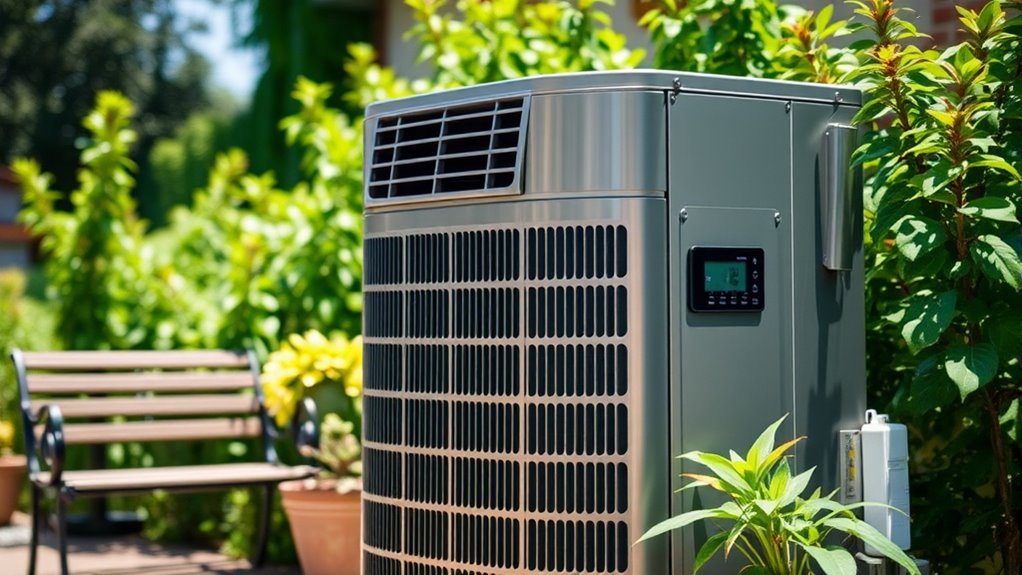
Choosing the right heat pump size is crucial for efficient and effective cooling, but many homeowners make common mistakes that can compromise performance. One mistake is neglecting proper load calculation, leading to oversizing or undersizing the unit. An oversized heat pump may cause short cycling, reducing efficiency and causing uneven temperature control, while an undersized unit runs constantly, increasing energy costs and wear. Relying on a rule of thumb, like assuming a standard capacity based on square footage, often results in choosing an incorrect size. To avoid these issues, consult an HVAC professional who can perform an accurate load calculation. Proper sizing ensures ideal capacity, improves efficiency, and prevents problems caused by mismatched system size. Additionally, considering system components and their impact on overall performance can help homeowners make informed decisions when upgrading their system. Incorporating energy efficiency ratings and features can further optimize the system’s long-term operation and savings.
How Professional Sizing Ensures Optimal Performance

Have you ever wondered how professionals guarantee your heat pump is just right for your home? They rely on detailed load calculations, like Manual J, to determine your home’s BTU needs based on factors such as insulation, climate, and size. Properly sized units match your thermal load, preventing issues like overcapacity, which can cause short cycling and reduce system lifespan. Selecting the right capacity ensures consistent comfort and energy efficiency. Here’s a quick comparison:
| Factor | Impact |
|---|---|
| Load calculations | Accurate sizing based on home’s specifics |
| Overcapacity | Leads to short cycling and higher wear |
| Proper sizing | Maximizes comfort and system longevity |
This process guarantees your system performs efficiently, saving you money and extending its lifespan.
Frequently Asked Questions
How Many Square Feet Will a 12000 BTU Heat Pump Cool?
You’re wondering how much space a 12,000 BTU heat pump can cool. Typically, this unit covers about 400 to 600 square feet, depending on factors like insulation, ceiling height, and window size. If your home is well-insulated, it might cool closer to 600 square feet. Keep in mind, getting the right size guarantees efficiency and comfort, so consider professional advice for precise sizing.
How Many Tons Is 60,000 BTUS?
You’re asking how many tons 60,000 BTUs equal. To figure that out, divide 60,000 by 12,000, which gives you 5. So, a system with 60,000 BTUs is a 5-ton heat pump or air conditioner. This capacity is ideal for cooling or heating larger spaces around 2,500 square feet, depending on insulation and climate. Proper sizing helps guarantee efficiency and comfort in your home or business.
How Do You Interpret Cooling Capacity?
Interpreting cooling capacity means looking at the BTU rating to see how well a heat pump can cool your space. If it’s 12,000 BTUs, it’s suitable for about 500-600 square feet. Larger BTUs handle bigger areas but can cause inefficiency if oversized. To get it right, match the BTU to your home’s size and insulation needs, often with a professional’s help to perform load calculations.
What Is the Cooling Limit for Heat Pumps?
You might think heat pumps cool effectively at all outdoor temperatures, but in reality, their cooling limit usually falls around 115°F to 125°F. When temperatures exceed this range, their efficiency drops, and they struggle to maintain cooling. Some advanced models handle up to 130°F, but even then, performance diminishes. Recognizing these limits helps you plan for additional cooling solutions during extreme heatwaves.
Conclusion
Choosing the right BTU size for your heat pump is like finding the perfect pair of shoes; too tight or too loose, and comfort suffers. When you select appropriately, it’s like a well-tuned instrument—delivering just the right amount of cool air without wasting energy. Remember, professional sizing guarantees your home stays cozy and efficient, turning a simple upgrade into a smart investment. Get it right, and you’ll enjoy cool comfort all season long.
